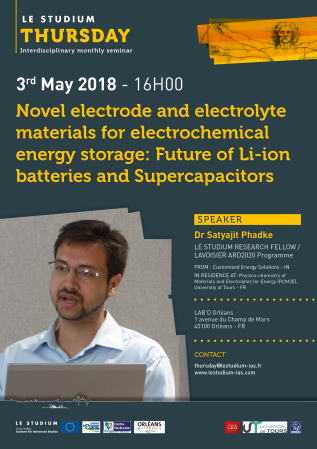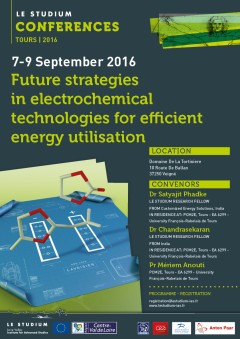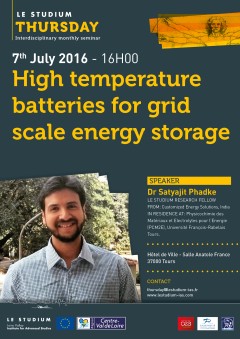Dr Satyajit Phadke

Field of research
Energy Storage and Conversion
From
Customized Energy Solutions - IN
In residence at
Physical Chemistry of Materials and Electrolytes for Energy (PCM2E) / University of Tours - FR
Host scientist
Prof. Mérièm Anouti
PROJECT
Energy storage systems (ARD 2020 LAVOISIER)
The research project focuses on Energy Storage and Conversion Technologies and is supported by the ARD 2020 LAVOISIER Programme. The objective of the project is to develop novel materials (electrolytes, positive and negative electrodes) for advanced energy storage devices. The research work performed on Lithium-sulphur batteries has lead to the expansion of the project in the form of industry funding for the next 2 years (2017 - 2019) from Arkema.
Publications
The recycling of lithium ion batteries has been mentioned as one of the near-future waste management necessities. In order for recycling to be economically viable, straightforward and cost effective techniques need to be developed to separate the individual materials in a composite electrode. Ultrasonic separation might be such a technique, provided that lithium ion battery microparticles respond predictably to a sound field. Lithium ion battery cathodes contain hydrophobic carbon. Owing to the incompressibility of a solid, the thin gaseous layer surrounding these hydrophobic particles must oscillate asymmetrically, when subjected to ultrasound. Consequently, the harmonic content of the ultrasound signal radiated from hydrophobic microparticles must be higher than that from hydrophilic microparticles with the same size. The question of whether the harmonic signal response generated by physical hydrophobic microparticles present in lithium ion battery cathodes is higher than the harmonic response of other component materials in the cathode is the focus of this paper. The scattering response of cathode materials subjected to 1-MHz ultrasound was measured and compared. The cathode materials C65, PVDF, and NMC respond differently to 1-MHz ultrasound. The superharmonic response of C65 has been attributed to asymmetric oscillations owing to its hydrophobicity. In addition, C65 hydrophobic microparticles might be suitable candidates for harmonic imaging.
Final reports
The sulphur electrode in LiS batteries suffers from rapid capacity loss and low efficiency due to the solubility of long chain polysulphides formed during discharge. Herein, we demonstrate the beneficial effect of original catholyte formulations containing redox active organyl disulphides (PhS2Ph) on the capacity utilization and retention as well as the efficiency in LiS batteries. Resulting from the chemical equilibria in the electrolyte between the sulphur/polysulphides (S8/Sx2-) and disulphide/thiolates (PhS2Ph/PhSx-), the polysulphide redox shuttle phenomenon is minimized due to the suppression of formation of soluble polysulphides (Sx2-, x > 4). Using the catholyte containing 0.4 M Ph2S2 as an additive in a standard base electrolyte (DOL/DME + LiTFSI/LiNO3), a stable capacity of 1050 mAh.g-1 is obtained under galvanostatic cycling at C/5 with a coulombic efficiency of >99.5%. At 45°C, it is shown that the formulated catholyte enables galvanostatic cycling at a high c-rate of 1C over 500 cycles with a capacity above 900 mAh.g-1 and a high energy efficiency of 82%.



